If you have followed my writing over the last five years, you will know that I genuinely love the moon phase complication, which is a highly poetic one that, unless you are a traditional seafarer, astrologer, or amateur astronomer, you probably don’t have much use for in your everyday life.
The moon phase display is something that connects us with our past because the moon and its phases were among our earliest scientific observations. Various cultures have had a fairly accurate understanding of moon phases for millennia and used the moon as an important timekeeping tool.
With the advent of modern telescopes and very accurate measurements, scientists now know very precisely how the moon orbits the earth and goes through its visual phases. We even understand how it varies its speed based on its apogee and perigee (closest and farthest point in an elliptical orbit) and the position relative to the sun.
We also understand how it undergoes libration, perhaps better described as wiggling around during its orbit so that the face visible to earth shifts slightly during the rotation. All these things cause its orbit around the earth – and therefore its phases – to vary throughout the year, so most of the time we rely on an average.
When it comes to moon phases, the average time it takes to go from full moon to full moon is 29.5 days.
Well, pretty much.
The moon’s actual synodic (period relative to the sun) time is 29 days, 12 hours, 44 minutes, and 2.8016 seconds. Though, again, this is an average.
Astronomy nerd side note: the moon has multiple defined periods for a lunar month, including sidereal, synodic, tropical, anomalistic, and draconic. The two that really matter to most people are sidereal and synodic. The sidereal month, which is used by astronomers, is the length of time it takes for the moon to return to the same position against an average of background stars. What matters for us watch nerds is the synodic interpretation, which is basically the phases as they relate to the relative alignment with the sun and earth. The average for the synodic month is 29.530587981 days. This will be important later (so please memorize this number).
Moon phase mechanisms in a watch can vary dramatically with design and accuracy, but the most basic moon phase mechanism uses a moon phase disk with 59 teeth and two moons that when advanced once a day makes a half rotation every 29.5 days. Tadaa! Easy peasy, but not very accurate.
With this configuration, it will only take two and a half years before the moon phase is slow by one full day, the standard measure for accuracy. This equates to over 30 seconds of loss every day, which would be unacceptable if it were the actual precision of the watch.
So, the next step was for watchmakers to make a system with a finer-toothed gear, boasting 135 teeth to be exact. With this new, more precise moon phase mechanism, many higher end watches have been able to bump that 2.5-year accuracy up to 122.5 years. This has become the de facto standard on high quality watches because it represents more than a lifetime of accuracy, much more than enough for the average consumer.
But, as with anything, accuracy is relative, and some people wanted more . . . much more. So super-accurate moon phase complications were developed out of mechanical curiosity. These take the accuracy levels to unprecedented levels features hundreds or thousands of years of accuracy. And more.
I previously wrote an article featuring the 8 most accurate mechanical moon phase watches in existence and now need to adjust the list to account for new timepieces introduced since 2015 as well as provide an updated look at my favorite useless complication. The purpose is to highlight the attempts at using mathematics and relatively simple mechanics to capture the motion of the universe, even if aspects like service intervals, intermittent storage periods, and built-in gear train inaccuracies make the mechanism more idealistic than practical.
In the first article I welcomed examples or suggestions that might be added to the list, and as of yet no additions were suggested that met the criteria for extreme accuracy. A frequent suggestion included any of the Ulysse Nardin Trilogy of Time pieces: the Astrolabium, Planetarium, and Tellerium. But upon further research it was never claimed outright that the accuracy of the moon phase was anything more than approximately 137 years and I could find no confirmation of the various claims suggested by readers.
What happens is that many watches claiming to be very accurate are only referring to the standard accuracy of approximately 122 years, with few exceptions for modified gearing. While this is still very good, today I want to share a list of the top 10 most accurate mechanical moon phase watches that I am aware of, with an honorable mention for a newcomer (that very well might have competition out there I am unaware of).
This particular watch has stood out as dramatically more than the standard, so I wanted to include it for posterity’s sake.
Without further ado, here is an updated list of the top ten (+1) most accurate mechanical moon phase wristwatches today.
Number 11 (honorable mention): Ferdinand Berthoud FB 1L
The Ferdinand Berthoud FB 1L features a very unique moon phase display that actually seeks to show the age of the moon along with the phase as a tool to aid in calculating longitude while navigating at sea, or at least in honor of the brand’s namesake and his work toward a related goal. The watch is incredible in many impressive ways, but the reason it makes this list with an honorable mention is thanks to its very accurate moon phase display that is only off by one day every 577 years.

Ferdinand Berthoud FB 1L on the wrist
Thanks to a very large-diameter driving cam the gear ratios are much more precise than most small displays, which leads to the increased accuracy.

Ferdinand Berthoud FB 1L ‘Near Side of the Moon’: what a cool moon display!
For more information, please visit www.ferdinandberthoud.ch/en/collection/chronometer-fb1L1.
Further reading: Ferdinand Berthoud FB 1L: When History Has A Date With Progress.
Quick Facts Ferdinand Berthoud FB 1L
Case: 44 x 13.95 mm, white gold or ceramized titanium
Movement: in-house manual winding Caliber FB-T.FC.L with fusée and chain with one-minute tourbillon, officially C.O.S.C. chronometer certified, pillar-style architecture, 3 Hz/21,600 vph frequency
Functions: hours, minutes, seconds; power reserve indication, age of the moon, moon phases
Limitation: 10 pieces in each version
Price: $278,500 for white gold Near Side of the Moon; $262,500 for anthracite-colored ceramized titanium Far Side of the Moon
Number 10: H. Moser & Cie Endeavour Moon/Endeavour Moon Concept Vantablack
The H. Moser & Cie Endeavour Moon starts the official list and kicks off the category of “super-accurate” moon phase complications at a very stout accuracy of 1,027.30 years before needing to be adjusted by one day. The feat was accomplished by calculating a gear train on the average period of 29.53059 days, thereby adding almost an entire millennium to its accuracy.

H. Moser & Cie. Endeavour Perpetual Moon Concept Vantablack on the wrist
In 2018 the brand released an updated version of the Endeavour Perpetual Moon featuring a Vantablack dial, stainless steel case, and the moon phase module placed on a different movement. All with an accuracy of 1,027.30 years!
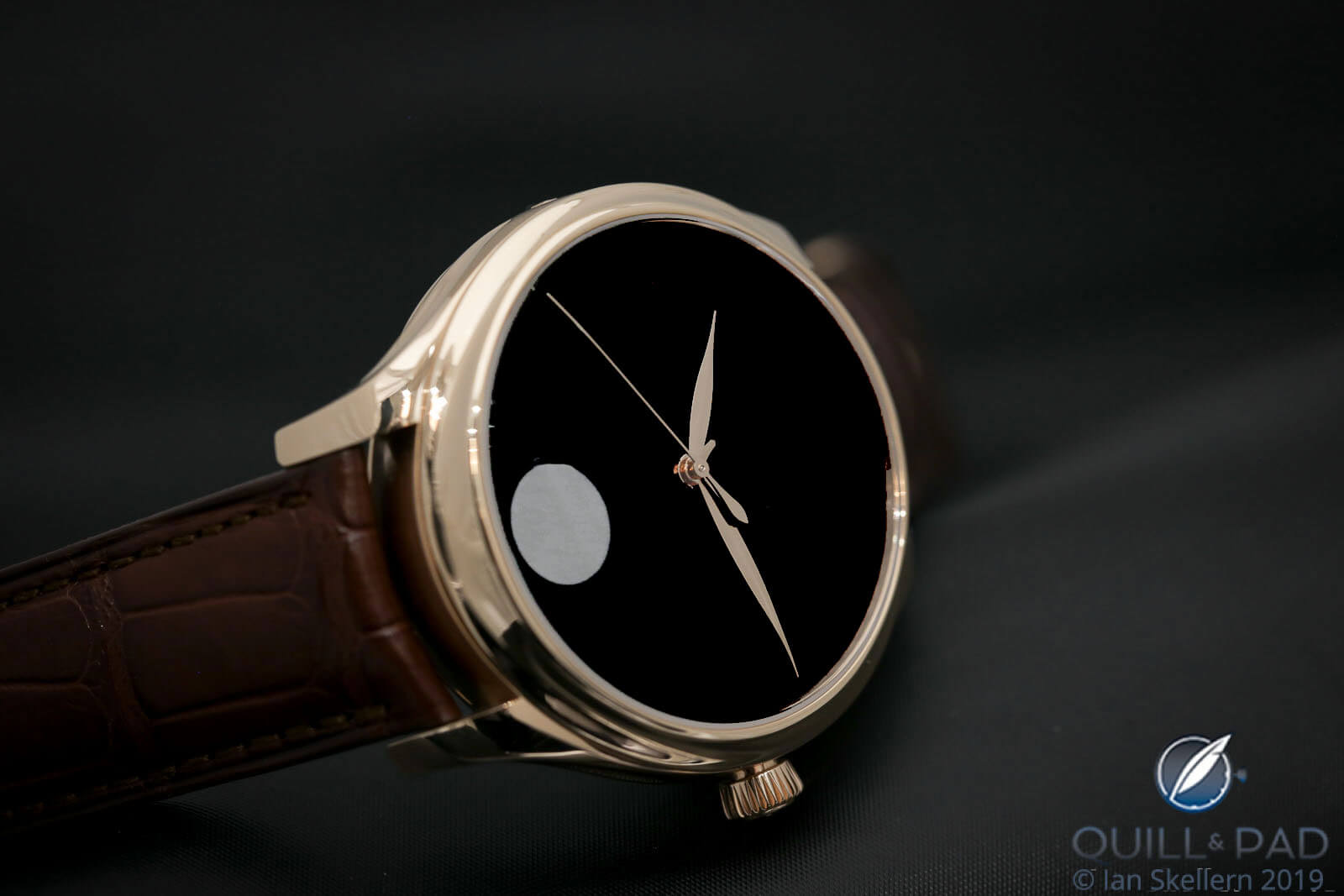
H. Moser & Cie. Endeavour Perpetual Moon Concept Vantablack
A little-known fact is that independent watchmaker Andreas Strehler was involved in the original design of this particular movement, which Elizabeth Doerr wrote about in H. Moser & Cie. Endeavour Perpetual Calendar On The Wrist.
Comparing this watch to the honorable mention of Ferdinand Berthoud, it is clear that things are going to escalate quickly!
For more information, please visit www.h-moser.com/en/collection/endeavour-perpetual-moon.
Quick Facts H. Moser & Cie. Endeavour Perpetual Moon Concept Vantablack
Case: 42 x 12.9 mm, red gold or stainless steel
Movement: in-house manual winding Caliber HMC 801 with 7-day power reserve; 2.5 Hz/18,000 vph frequency, twin spring barrels, Straumann hairspring
Functions: hours, minutes, (hacking) seconds; day/night indication, moon phase
Limitation: 50 pieces
Price: $35,000
Number 9: A. Lange & Söhne Richard Lange Perpetual Calendar Terraluna
Next on the list is the formidable Saxon brand known for other amazing creations such as the Zeitwerk Decimal Repeater and the Double Split and Triple Split. A. Lange & Söhne pushed the envelope with the Terraluna, using a slightly different calculation for the gear ratios than Moser to achieve an accuracy of 1,058 years, edging them out in the “super-accurate” category.

A. Lange & Söhne Terraluna
The moon also completes an orbit around a rotating earth visible on the back of the watch thanks to a planetary gear system. Even more surprisingly, that wasn’t a pun.

A. Lange & Söhne Richard Lange Perpetual Calendar Terraluna
This watch was a winner at the 2014 edition of the Grand Prix d’Horlogerie de Genève in the calendar category, the same edition during which Walter Lange won the Special Jury Prize. You can learn about it in the context of its introduction by reading Give Me Five! Perpetual Calendars From SIHH 2014 and in the context of the 2014 Grand Prix d’Horlogerie de Genève by reading Reflections On The 2014 Grand Prix d’Horlogerie de Genève.
For more information, please visit www.alange-soehne.com/en/timepieces/richard-lange-perpetual-calendar-terraluna.
Quick Facts A. Lange & Söhne Richard Lange Perpetual Calendar Terraluna
Case: 45.5 x 16.5 mm, white or pink gold
Movement: in-house manual winding Caliber L096.1
Functions: hours, minutes, seconds; perpetual calendar with date, day, and month, moon phase and position, 24-hour display
Price: €220,900
Number 8: Patek Philippe Sky Moon Tourbillon
At number 8 we meet a “living” legend in the Patek Philippe Sky Moon Tourbillon. Seriously, this watch is epic by any definition (including price). But what is even more epic is that the celestial display on the back was developed by calculating 25 trillion (25,000,000,000,000) gear train ratio variations searching for the best possible combination for all of the indications involved.

Patek Philippe Reference 5001T Sky Moon Tourbillon
The final ratios chosen resulted in a moon phase that loses 6.51 seconds every synodic month. In more relative terms (if my math is correct), this means the moon phase will be one full day behind every 1,073.06 years.

Patek Philippe Sky Moon tourbillon
For more information, please visit www.patek.com/en/collection/grand-complications/6002G-010.
Further reading: Sky Moon Tourbillon in The Patek Philippe Sky Moon Tourbillon Earns A Place In Horological History.
Quick Facts Patek Philippe Sky Moon Tourbillon
Case: 44 x 17.35 mm, white gold
Movement: in-house manual winding Caliber R TO 27 QR SID LU CL
Functions: hours, minutes, perpetual calendar, minute repeater, celestial moon age, sidereal time, sky chart, phases and orbit of the moon
Price: on request
Number 7: De Bethune DB28 Digitale
At number seven we come to one of my favorite brands and definitely a favorite watch of mine: the De Bethune DB28 Digitale. This watch makes my heart melt with lust, and it would make my wallet melt, too. But regardless of all that, it takes its job as a precision instrument seriously.
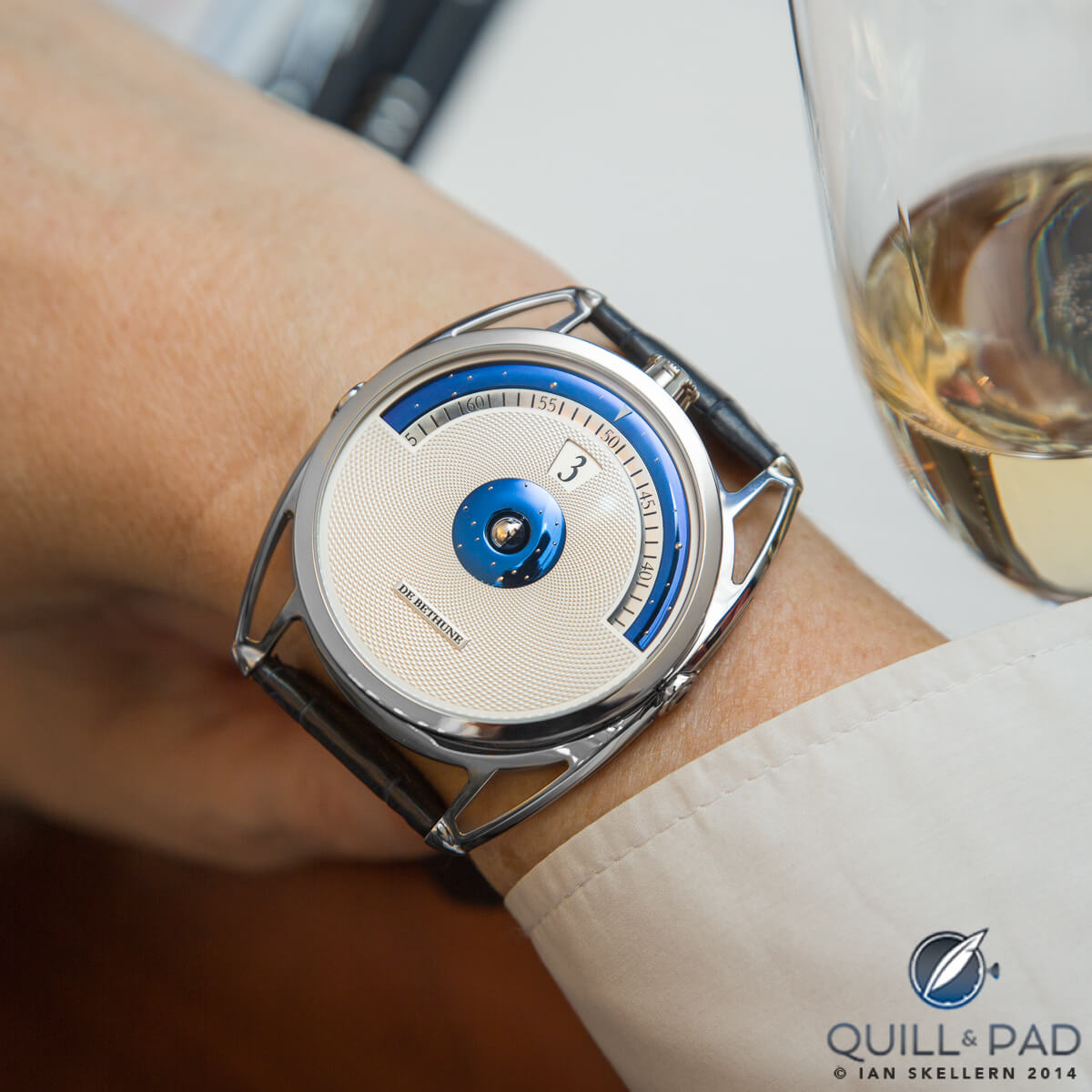
De Bethune DB28 Digitale on the wrist
The tiny half-polished, half-blued spherical moon rotates so accurately that it is also the one that comes closest to adding a full one thousand years in accuracy over the standard high precision. This piece will only be off by one full day every 1,112 years. Geez.

De Bethune DB28 Digitale
For more information, please visit www.debethune.ch/en/collections/db28-collection/db28-digitale.
Further reading: The Nine Muses And The De Bethune DB28 Digitale.
Quick Facts De Bethune DB28 Digitale
Case: 45 x 11.6 mm, titanium
Movement: in-house manual winding Caliber DB2144
Functions: jumping hours, minutes; moon phase
Price: CHF 95,000
Number 6: Ochs und Junior Moon Phase
With number six, though, the entire game shifts into overdrive and we enter the “super-duper-precision” moon phase category. The Ochs und Junior Moon Phase does that shift with a tiny amount of parts too, five to be exact. With those five parts, which make up an epicyclic gear train, moon phase accuracy more than triples that of the De Bethune DB28 Digitale listed at number 7 in this countdown.
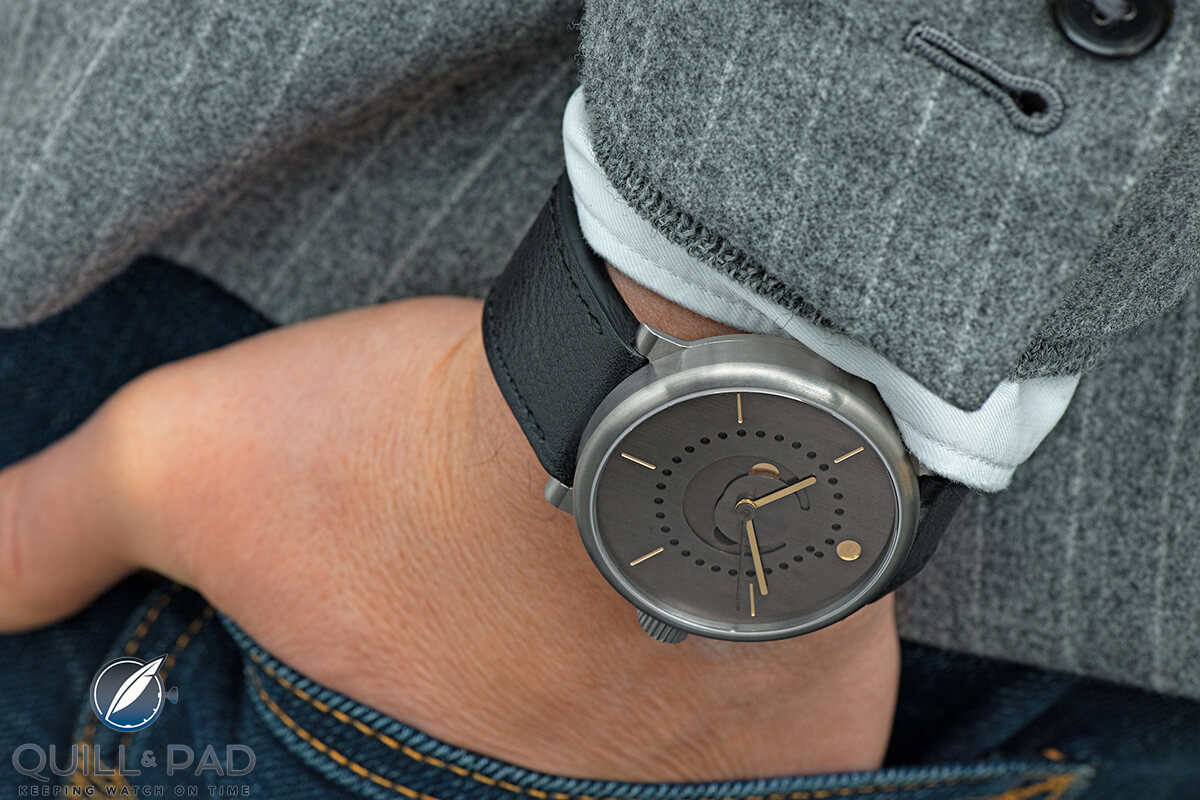
Ochs und Junior Moon Phase with patina dial
Calculating the synodic month with the ratios on the gear train, Ochs und Junior obtains a period of 29.5306122449 days. This means that to be off by one day it will take in incredible 3,478.27 years. With this number we begin to see the sheer engineering genius at play in these watches.

Ochs und Junior Moon Phase
For more information on this timepiece, please visit www.ochsundjunior.ch/watches/moon-phase.
Quick Facts Ochs und Junior Moon Phase
Case: 36/39/42 x 11 mm, titanium or sterling silver
Movement: automatic Caliber ETA 2824-2
Functions: hours, minutes; moon phase
Price: customizable, beginning at CHF 7,400
Number 5: Jaeger-LeCoultre Duomètre Sphérotourbillon Moon
The Ochs und Junior is hot on the heels of the number 5 watch in this listing, which also happens to be one of my absolute favorite Jaeger-LeCoultre timepieces.

Jaeger-LeCoultre Duomètre Sphérotourbillon Moon
The Duomètre Sphérotourbillon Moon is one fantastic watch, and it also has a moon phase boasting accuracy almost 12 percent longer than the next best. The Duomètre Sphérotourbillon Moon will only be one full day off after a whopping 3,887 years!
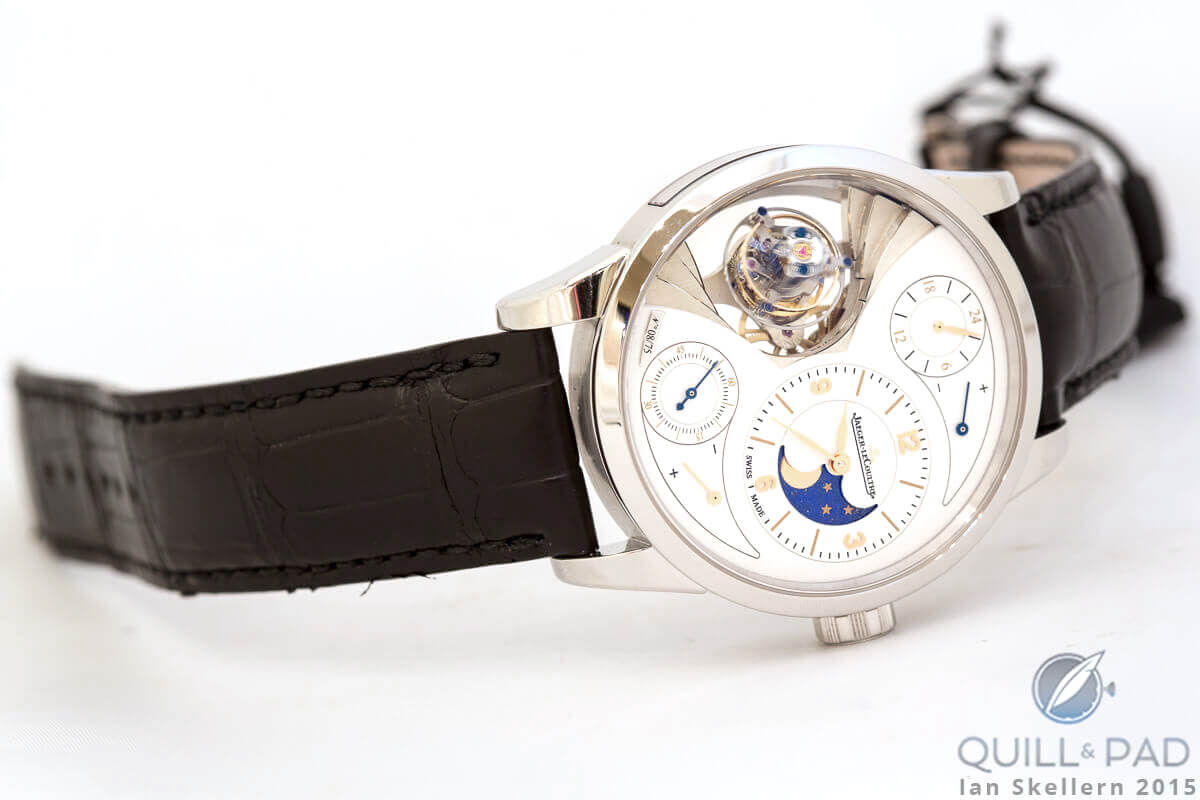
Duomètre Sphérotourbillon Moon by Jaeger-LeCoultre
This really is a battle of David versus Goliath as Jaeger-LeCoultre edges out Ochs und Junior by a bit more than 408 years.
Further reading: Precession Obsession: Jaeger-LeCoultre Duomètre Sphérotourbillon Moon.
Quick Facts Jaeger-LeCoultre Duomètre Sphérotourbillon Moon
Case: 42 x 14.3 mm, platinum
Movement: manually wound Caliber 389 with dual-wing architecture and bi-axial tourbillon inclined 20 degrees
Functions: hours, minutes, flyback seconds; moon phase, 24-hour display, dual power reserve
Limitation: 75 pieces
Price: €225,000
Number 4: Christiaan Van der Klaauw Real Moon Joure
You know how I just said we entered the category of “super-duper-precision” moon phase watches? Yeah, well now we’ve left that and entered the “ultra-precision” category. And I mean it.

Christiaan van der Klaauw Real Moon Stella Nebula with Ammolite dial
Long known as the king of astronomical watches, Christiaan Van der Klaauw took no prisoners when designing the mechanism for the Real Moon Joure.

Christiaan Van Der Klaauw Real Moon Joure Horizon
With an ultra-realistic, three-dimensionally shaped moon, this watch will only be off by one day after . . . are you ready for this? . . . 11,000 years! This means the Real Moon Joure is only off by less than eight seconds per year. Now if only the mechanical chronometry could be that precise!
For more information, please visit www.klaauw.com/eng/cvdk-real-moon-joure.
Quick Facts Christiaan Van der Klaauw Real Moon Joure Stella Nebula
Case: 40 mm, pink or white gold
Dial: Ammolite with three-dimensional moon phase in white and black diamonds
Movement: automatic Caliber CVDK7382 with CVDK Real Moon Joure module
Functions: hours, minutes; moon phase
Limitation: 5 pieces total, 2 pink gold, 2 white gold and 1 unique piece in white gold with diamond bezel
Price: 90,000 Swiss francs (white gold), 85,000 Swiss francs (pink gold), 110,000 Swiss francs (white gold with diamond bezel)
Number 3: Stepan Sarpaneva Lunations
The Stepan Sarpaneva Lunations is a newcomer to the list and, boy, does it make a valiant attempt for the belt! Using an entirely new in-house movement and a never-before-seen moon phase indication, the Lunations uses a large diameter and high tooth count to get a very precise set of gear ratios that drive this mechanism into the realm of “ultra-accurate” moon phases.

Sarpaneva Lunations
In the current configuration, Lunations surpasses the Real Moon Joure (number four) by three millennia, pushing its accuracy to one full day’s deviation after 14,000 years!

Sarpaneva Lunations
When you combine that level of accuracy with the very cool fiber optic moon display, it makes this piece something to contend with. Since this precision is far beyond anything needed in our lifetimes, it also makes the Lunations an ultra watch for true moon fanatics!
For more information, please visit www.sarpanevawatches.com/sarpaneva-lunations.
Further reading: Sarpaneva Lunations: The Latest Moonphase Tech That Lasts (Almost) Forever.
Quick Facts Sarpaneva Lunations
Case: 42 x 9.8 mm, Outokumpu Supra 316L/4435 stainless steel or 18-karat red gold
Movement: manual winding in-house Moonment caliber, 60-hour power reserve, 3 Hz/21,600 vph frequency
Functions: hours, minutes; optical fiber moon phase
Price: beginning at €32,000 for stainless steel
Number 2: Andreas Strehler Sauterelle à Lune Perpétuelle
Nudging out the younger Sarpaneva Lunations, Andreas Strehler released the Sauterelle à Lune Perpétuelle at Baselworld 2014 and in doing so created the watch with the most accurate moon phase ever up until that point. And he used only four extra components. Yikes!
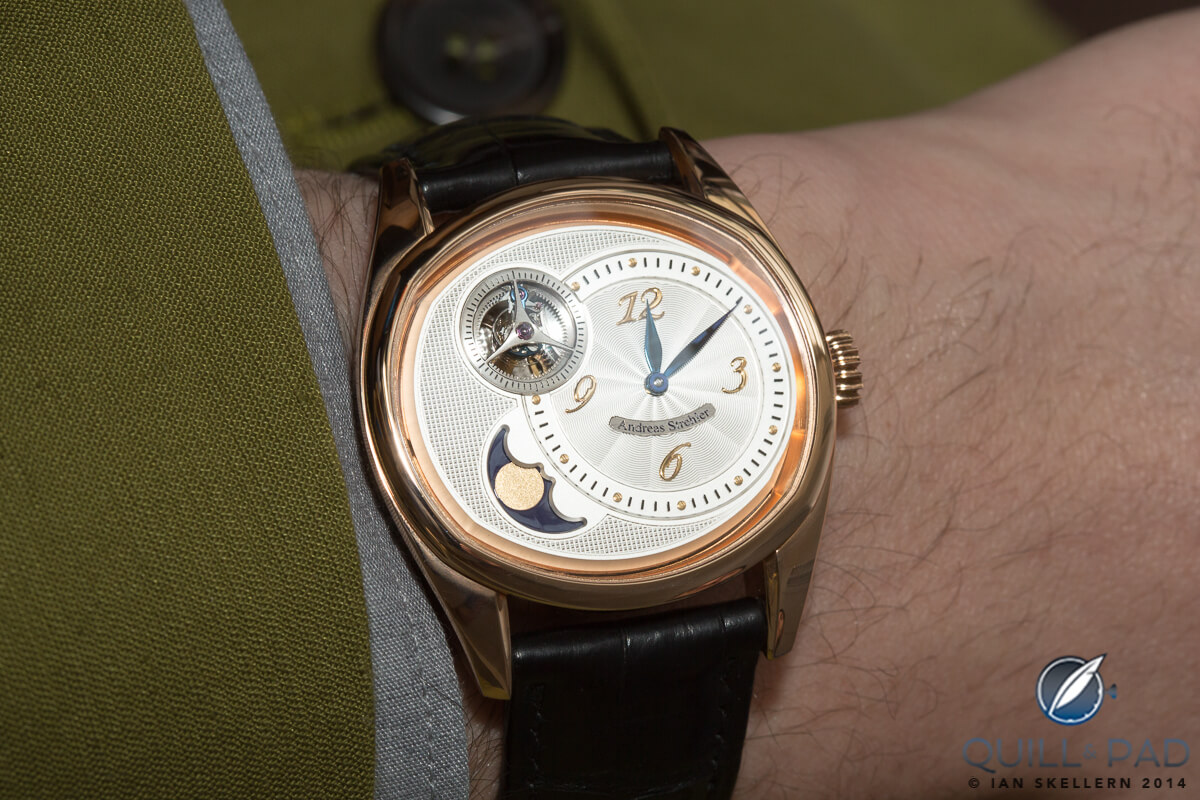
Sauterelle à Lune Perpétuelle fitting very nicely on the wrist
It was a serious feat because the moon phase is being constantly driven. The moon phase utilizes internal and external gear teeth. And Strehler employed prime numbers for the teeth, creating very complex fractions and an accuracy bordering on insanity.

Sauterelle à Lune Perpétuelle by Andreas Strehler
And just how insane is it? It will take 14,189.5383 years for the moon phase to be off by just one day!
For more information, please visit www.astrehler.ch/sauterelle-a-lune-perpetuelle.
Quick Facts Andreas Strehler Sauterelle à Lune Perpétuelle
Case: 41 x 10 mm, red gold or platinum
Movement: manually wound manufacture Calibre Sauterelle Lune Perpétuelle outfitted with remontoir d’égalité for constant force
Functions: hours, minutes, perpetual moon phase, which needs adjustment by one day only every 14,189.538 years
Price: CHF 96,000 plus applicable tax
But wait, there’s more!
The still reigning king of the moon phase is . . .
Number 1: Andreas Strehler Sauterelle à Lune Perpétuelle 2M, the most accurate moon phase ever in a wristwatch
So the story behind the Sauterelle à Lune Perpétuelle gets better. As Strehler presented his watch at Baselworld 2014, he also mentioned how he had written a computer program to calculate the gear teeth ratios to achieve the best accuracy he could.
As a side note, he mentioned that he actually had another ratio that was far more accurate than the one in the Sauterelle à Lune Perpétuelle, but it seemed almost crazy and overkill to put it into a watch.
A couple months later he did just that.
Utilizing the same number of parts and simply changing the ratios and number of teeth, Strehler was able to shatter the previous record and move into his own category: fundamentally perfect.

Andreas Strehler Sauterelle à Lune Perpétuelle 2M
This new version of the watch has a moon phase 145 times more accurate than its own predecessor. The Sauterelle à Lune Perpétuelle 2M will be off by one single day after, get this, 2,060,757 years.
That’s not a typo: 2.06 million years!
This is such a long amount of time that the moon phase can be considered perfect, because by the time you would need to adjust it by one day. In 2.06 million years, the rotational period of the earth, the moon, and the relative orbits of both will have changed by such a degree that, because the moon is gradually moving away from the earth, our days will be about 36 seconds longer than they are now and every calculation will be null and void for multiple reasons.
So, basically, this is a perfect moon phase watch. It can’t be made any more perfect for the simple reason that the numbers involved in calculating it will change in less time than it requires adjusting the moon phase by a single day to be in sync again.
Boom!
*Andreas Strehler drops the mic and walks away*
*Cheers and applause, then silence*
*Andreas Strehler remembers something and picks up the mic again*
Of course Strehler is never one to let a good thing go, so he did what I previously said couldn’t be done, he made the perfect moon phase even more perfect. Not by changing the accuracy, that still is fundamentally perfect at 2.06 million years and anything more is probably the best definition of pointless. No, Strehler decided to make his moon phase utterly more easy to use and precise to set and adjust. Before the moon phase needed to be set based on the full moon or new moon position and then the time adjusted to get it as close as possible.

Andreas Strehler Lune Exacte
Strehler has since introduced a new watch named the Lune Exacte that features the same moon phase function but adds a Vernier scale to chart the age of the moon so that one can now adjust the moon phase to within three hours precision at any time throughout the synodic month. The best bet for accuracy is still to set it based on the exact time of a full or new moon, but now you can set it nearly perfectly at any time throughout the month and then adjust perfectly at the top of the phase.
While it doesn’t add more accuracy to the mechanism it does add precision to the setting and adjustment of it, and the sheer usability of the mechanism for the average user. This means the Lune Exacte is tied for first place with the Sauterelle à Lune Perpétuelle 2M, but since the top three watches are all by Andreas Strehler, I’m guessing he won’t mind.
For more information, please visit www.astrehler.ch/sauterelle-a-lune-perpetuelle-2m.
Further reading: Blood Moons, Lunar Tetrads, And The Andreas Strehler Sauterelle A Lune Perpétuelle and Andreas Strehler Entered Into ‘Guinness Book Of World Records.’
Quick Facts Andreas Strehler Sauterelle à Lune Perpétuelle 2M
Case: 41 x 10 mm, red gold or platinum
Movement: manually wound manufacture Caliber Sauterelle Lune 2M outfitted with remontoir d’égalité for constant force; perpetual moon phase needing adjustment by one day only every 2.06 million years
Functions: hours, minutes, perpetual moon phase
Price: CHF 96,000 (red gold), CHF 113,000 (platinum)
Quick Facts Andreas Strehler Lune Exacte
Case: 41 x 10 mm, red gold or platinum
Movement: manually wound manufacture Caliber Sauterelle Lune Exacte outfitted with remontoir d’égalité for constant force; perpetual moon phase needing adjustment by one day only every 2.06 million years
Functions: hours, minutes; perpetual moon phase, age of moon scale
Price: CHF 112,000 (red gold), CHF 125,000 (platinum)
If moon phases interest you – and the chances are that if you have made it this far, then they do – you will probably love the moon phase app developed by Finnish independent watchmaker Stepan Sarpaneva, which is available free for both Android and iPhone.
* This article was first published on May 5, 2019 at The 10 Most Accurate Moon Phase Wristwatches Today (Plus Honorable Mention).
You may also enjoy:
Ferdinand Berthoud FB 1L: When History Has A Date With Progress
The 8 Most Accurate Moon Phase Wristwatches Today
Sarpaneva Lunations: The Latest Moonphase Tech That Lasts (Almost) Forever
The Nine Muses And The De Bethune DB28 Digitale.
Precession Obsession: Jaeger-LeCoultre Duomètre Sphérotourbillon Moon
Blood Moons, Lunar Tetrads, And The Andreas Strehler Sauterelle A Lune Perpétuelle





















































Leave a Reply
Want to join the discussion?Feel free to contribute!